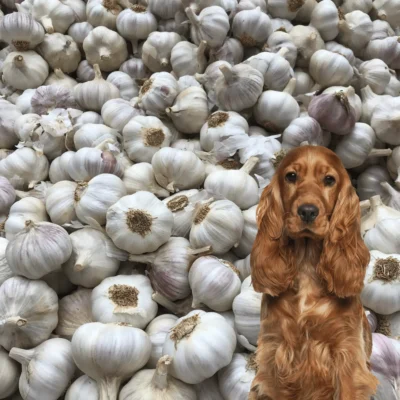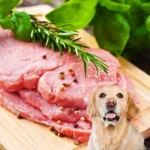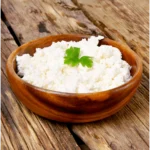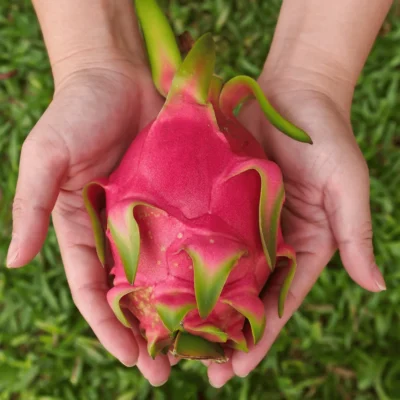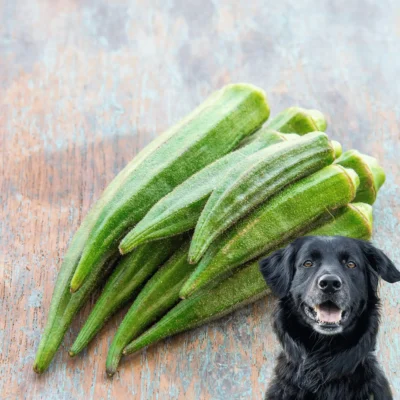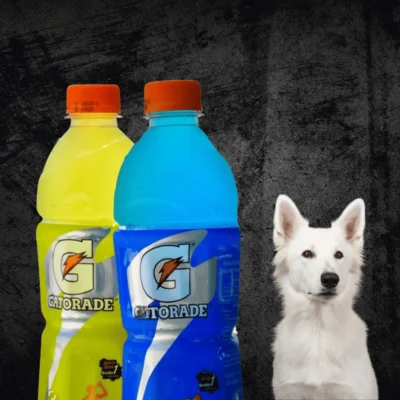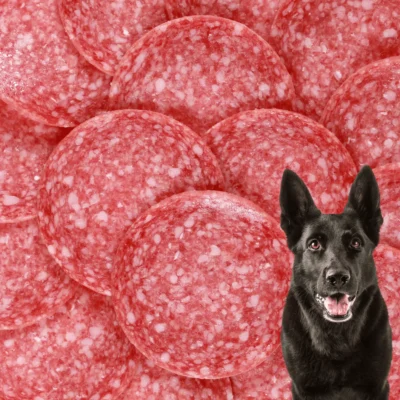Garlic is a popular ingredient in human cooking, valued for its flavor and perceived health benefits such as germ-fighting properties. It’s frequently used in different dishes, tempting us with its scent. But the question arises: can dogs eat garlic? The answer is a definite no. Dogs shouldn’t eat garlic because it’s not safe for them.
In this article, we will delve into the dangers of feeding garlic to dogs, exploring the reasons behind its toxicity and the potential risks associated with its ingestion. Understanding why dogs should steer clear of garlic is essential for responsible pet ownership and safeguarding the health and well-being of our four-legged family members.
Here’s a breakdown of the topics covered in the blog post:
- Is Garlic Safe for Dogs to Eat?
- How Much Garlic is Considered Toxic to Dogs?
- Can Dogs Eat Garlic Salt and Garlic Powder?
- Can You Feed Your Dog Garlic Bread?
- Can You Feed Your Dog Garlic Supplement?
- Identifying Signs of Garlic Poisoning in Dogs
- What Should I Do If My Dog Eats a Large Amount of Garlic?
- If Garlic is Toxic to Dogs, Why Do Some Experts Recommend It?
Is Garlic Safe for Dogs to Eat?
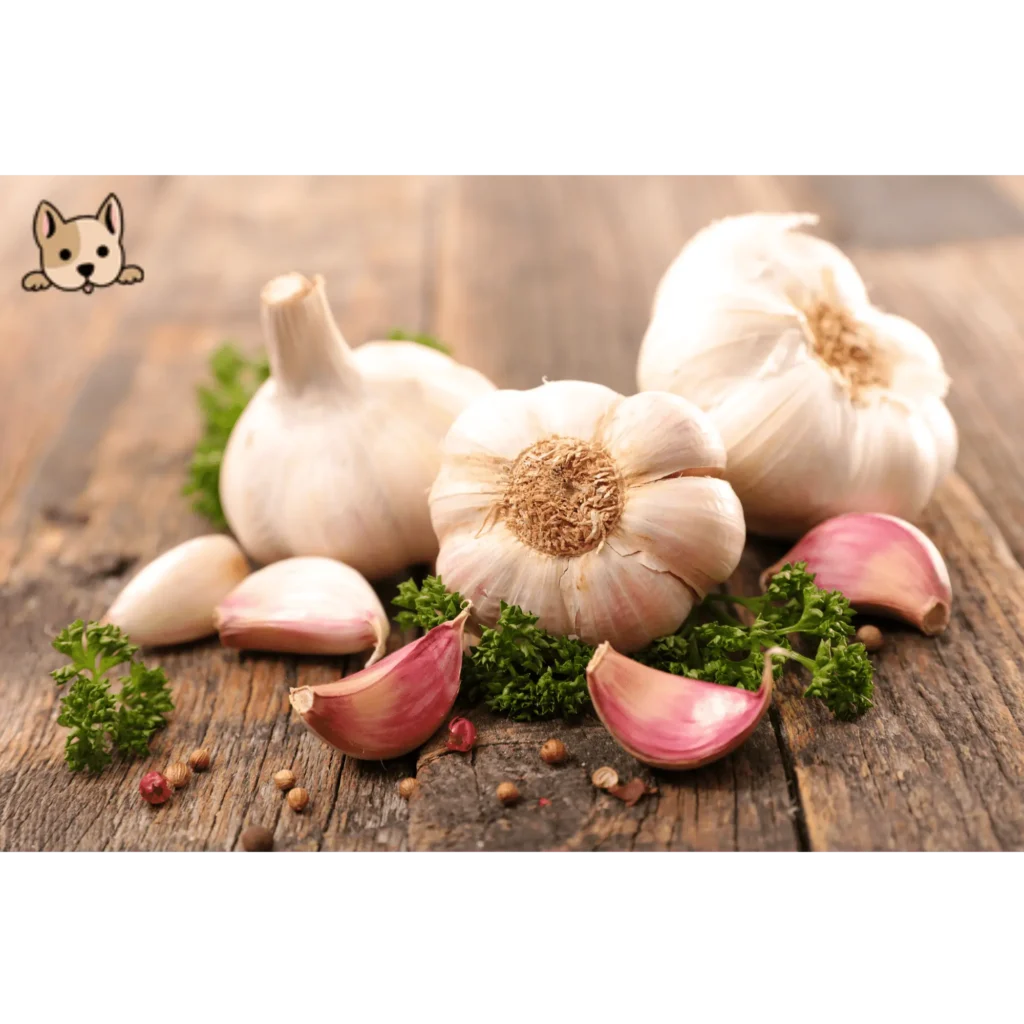
Dogs should never consume garlic. Despite its historical use in human diets for both flavor and health benefits, garlic poses significant risks to our furry companions. Although it is derived from nature, garlic contains substances that are toxic to dogs. As a member of the allium family, which also includes onions and leeks, garlic contains compounds that can be harmful to our four-legged friends.
Thiosulfate, a component found in garlic, can cause oxidative damage to red blood cells in dogs, resulting in a severe condition called hemolytic anemia. This condition presents with symptoms such as pale mucous membranes, rapid breathing, lethargy, weakness, jaundice, and dark urine. Additionally, ingestion of garlic by dogs can lead to gastrointestinal distress, including vomiting, diarrhea, loss of appetite, abdominal pain, depression, and dehydration.
Given these severe risks, it is crucial to keep garlic and other allium plants away from dogs to protect their health and well-being.
How Much Garlic is Considered Toxic to Dogs?
Studies show that for dogs, it takes about 15 to 30 grams of garlic per kilogram of their weight to cause harm. To give you an idea, a typical garlic clove weighs between 3 to 7 grams. So, dogs would need to eat a lot of garlic to get sick. But it’s important to know that some dogs might be more sensitive, and even a little garlic over several days could be bad.
While a small amount of garlic accidentally eaten may not hurt your dog right away, giving them garlic on purpose is not a good idea. The risks of garlic poisoning, especially if they eat a lot or keep eating it, are much bigger than any possible benefits. So, it’s smart to keep garlic and other similar foods away from your dog to keep them safe.
Can Dogs Eat Garlic Salt and Garlic Powder?
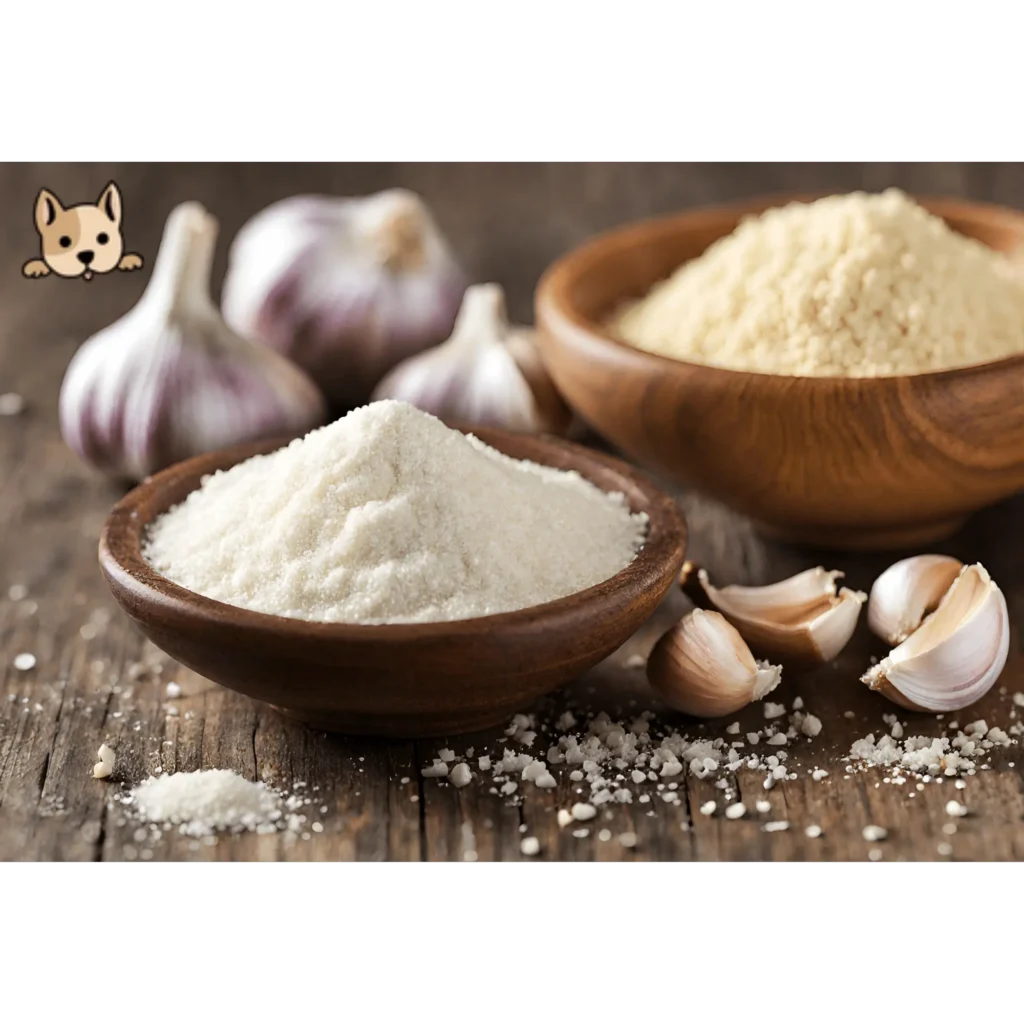
Garlic salt and garlic powder are much stronger forms of garlic compared to fresh cloves. Even small amounts of these can be harmful to your pet. Many cases of garlic poisoning in pets happen because of the concentrated forms used in cooking.
Since garlic salt and powder are stronger, they can make pets sick even if they eat just a little. So, pet owners need to be careful and not use garlic salt or powder in any food given to their dogs or other pets. It’s better to use safe seasonings instead to keep pets healthy and avoid any accidents.
Can You Feed Your Dog Garlic Bread?

Garlic bread might smell tempting to your dog, but it’s not a good idea to share it. Besides garlic, garlic bread often contains ingredients like butter, oil, cheese, and herbs that can upset your dog’s stomach. These extra ingredients can cause tummy troubles for your furry friend.
Plus, garlic bread is high in calories and fat, which isn’t good for dogs. Eating too much fatty food, like garlic bread, can make dogs gain weight and lead to health issues like obesity.
It’s better to stick to healthy treats made specifically for dogs and avoid giving them garlic bread or similar foods. Choosing nutritious snacks keeps your dog healthy and avoids problems that come with fatty, low-nutrient foods like garlic bread.
Can You Feed Your Dog Garlic Supplement?
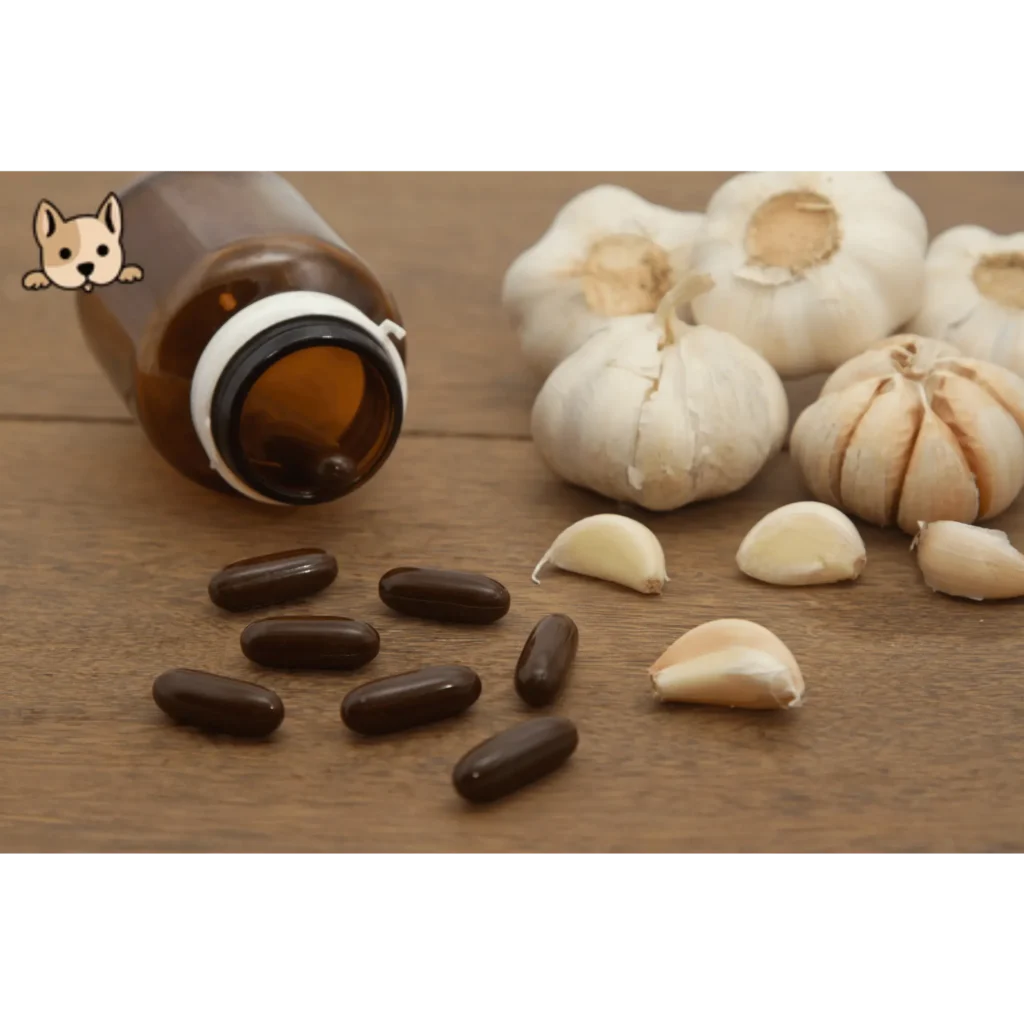
Some websites and dog owners might suggest garlic supplements for dogs as part of a natural health plan or to prevent fleas and ticks. But this advice can be misleading and even harmful. While some people say garlic supplements help dogs, scientific studies don’t consistently show this.
Even though tiny amounts of garlic might be okay for some dogs, we can’t ignore the risks of garlic poisoning and the lack of proof that it really works. Before giving your dog a garlic supplement, it’s crucial to talk to your vet. Only a qualified vet can give you the right advice based on your dog’s health.
If you give your dog too much garlic supplement, it can make them sick. So, working with your vet to come up with the best health plan for your dog ensures they get the right nutrition without any risks.
Identifying Signs of Garlic Poisoning in Dogs:
If you think your dog has eaten garlic, it’s really important to talk to your vet right away. Recognizing the signs of garlic poisoning can help catch it early and get help fast. Some common symptoms of garlic poisoning in dogs are:
- Lethargy (being really tired)
- Stomach pain
- Throwing up
- Diarrhea
- Drooling a lot
- Heavy breathing
- Weakness
- Trouble walking straight
- Pale gums
- Faster heartbeat or breathing
- Pee that’s red or brown
- Lots of drool
- Blue gums or skin
But sometimes, the effects of garlic poisoning can take time to appear. If you suspect your dog has eaten garlic, it’s crucial to contact your vet without delay.
Acting fast is key to helping your dog if they’ve eaten garlic. Your vet can give you the right advice and treatment to help your dog feel better and stay healthy.
What Should I Do If My Dog Eats a Large Amount of Garlic?
If your pet eats a lot of garlic, don’t wait for them to get sick. Some symptoms of garlic poisoning can show up days later, and treating them later can be hard and expensive.
If your dog eats garlic, call a vet, a pet consulting service, or poison control right away. They can check if your pet needs medical care or if you can watch them at home for signs of poisoning.
Even if your dog eats just a little garlic (less than a clove) or eats some chicken cooked with garlic, they might not show symptoms right away. Still, it’s important to talk to a vet to make sure everything’s okay. While you might think about making your pet throw up, it’s safer to let the vet handle it to avoid problems.
If your pet eats garlic bread, call your vet to know what to do next. Depending on how much garlic they ate, the vet might tell you to watch for upset stomach signs or to bring your pet in for treatment. If they ate a lot, the vet might make them throw up and watch them overnight to make sure they’re okay.
If Garlic is Toxic to Dogs, Why Do Some Experts Recommend It?
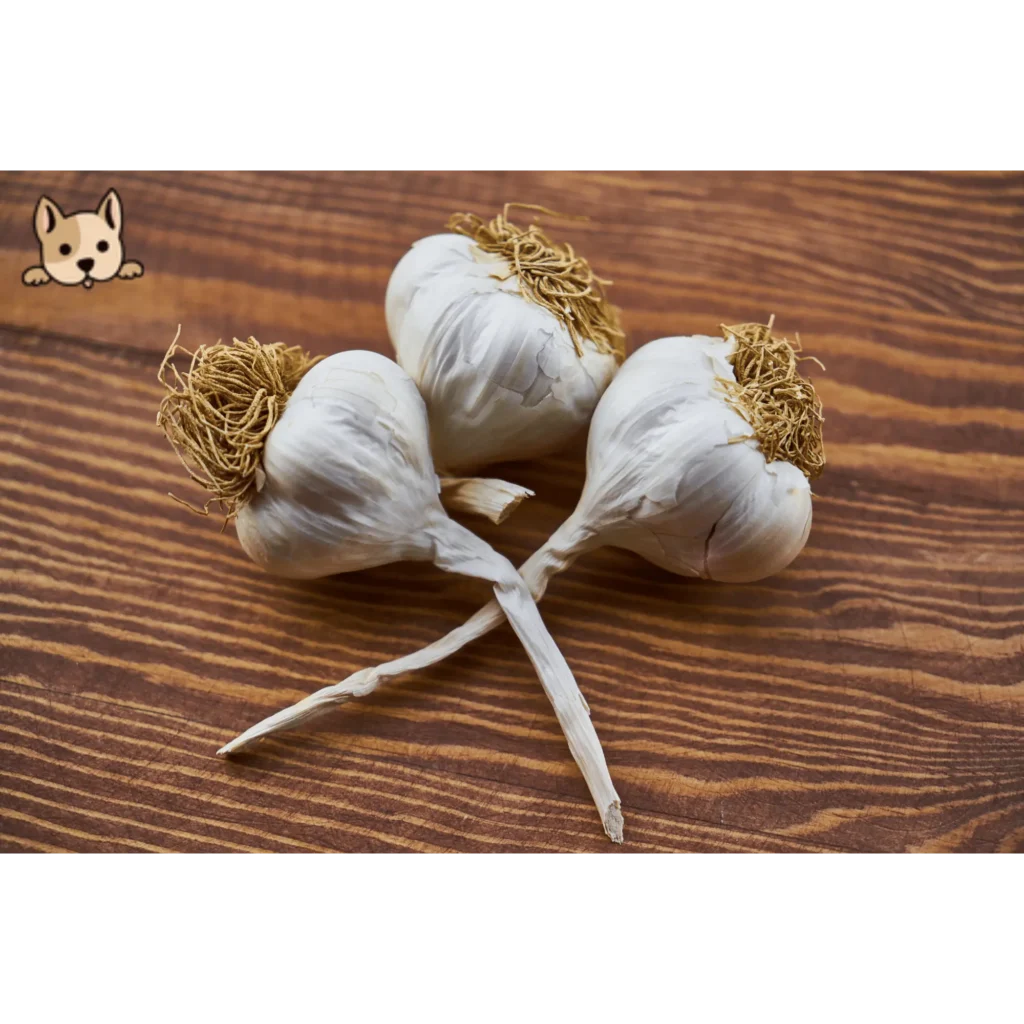
The mixed messaging surrounding the use of garlic for dogs can indeed be confusing. While some sources may tout the potential benefits of garlic for dogs, it’s essential to understand that the quantity consumed plays a critical role in determining the risk of toxicity.
In theory, very small amounts of garlic may not cause harm to dogs, and some individuals believe that the nutrients found in garlic could be beneficial. However, determining a precise “safe” quantity of garlic is challenging, and this threshold may vary among individual dogs. Given the potential risks associated with garlic toxicity, it’s generally not worth the risk of intentionally feeding garlic to dogs.
It’s important to remember that dogs can obtain all the necessary vitamins and minerals from a complete and balanced pet food diet, which does not require supplementation with garlic or other potentially harmful ingredients.
For further guidance on providing a balanced diet for your dog and identifying harmful foods to avoid, it’s advisable to consult reputable sources and consider the advice of veterinary professionals. If you’re uncertain about whether a particular food is safe for your dog, it’s always best to err on the side of caution and refrain from offering it to them.
Final Thought:
In summary, while garlic is cherished in human cooking and believed to have health benefits, it’s risky for dogs. Scientific evidence consistently shows that even small amounts can harm them, causing serious conditions like hemolytic anemia and stomach problems.
As responsible pet owners, it’s crucial to avoid giving dogs anything with garlic, including supplements, salt, powder, bread, or dishes cooked with garlic. Stick to safe treats made for dogs to meet their nutritional needs without risking their health.
Knowing the signs of garlic poisoning and getting vet help quickly if your dog eats garlic is essential. By staying informed about dangerous foods like garlic, we can create a safe environment for our dogs, ensuring they live long, healthy lives. Ultimately, putting their well-being first guarantees a lifetime of joy and companionship with our furry friends.
FAQs:
What happens if my dog eats garlic?
Eating garlic can harm dogs. It damages their red blood cells and makes their stomach upset, causing things like tummy pain, throwing up, and diarrhea. Even though some people think a little garlic is good for dogs, it’s just not safe. It’s best to avoid giving dogs any garlic at all. If you think your dog ate garlic, get help from the vet right away. It’s important to keep our furry friends safe from things that can make them sick.
How much garlic is safe for dogs?
Studies indicate that it takes around 15 to 30 grams of garlic per kilogram of a dog’s weight to lead to harmful effects in their blood. For instance, a single clove of garlic usually weighs between 3 to 7 grams. Therefore, for dogs weighing between 10 to 15 pounds, it’s recommended they don’t consume more than half a clove of garlic per day. If you’re worried about how much garlic your dog is eating, it’s wise to seek personalized advice from your veterinarian.
Can I rub garlic on my dog?
Some people think garlic can keep fleas away from dogs, but it can be harmful to pets. It’s safest to avoid giving garlic to your dog at all, or if you’re thinking about it, talk to your vet first. They can help you make the best choice for your pet’s health.
How much can I give my dog for fleas?
Giving garlic to pets can be risky, so it’s generally not recommended by vets. Even though some suggest using fresh, organic garlic cloves, it’s important to be cautious. The recommended dosage is 1/4 clove per every 10 pounds of body weight, or half that amount for pets under 10 pounds. But it’s best to talk to your vet first to make sure it’s safe for your pet.
Is onion poisonous to dogs?
Onions are harmful to dogs and should never be eaten. Onions contain a substance called N-propyl disulfide, which can cause a breakdown of red blood cells, leading to anemia in dogs. This toxin damages the red blood cells by attaching to the oxygen molecules, causing oxidative damage.






